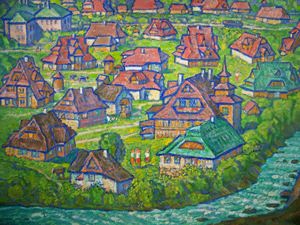“The surname Mohyla was like a verdict in 1932”
Hennadii Poliovy tells the story of his family and 20 sunflowers
The Ukrainian graphic artist and op-ed journalist Hennadii POLIOVY was born on June 3, 1927, in Odesa to Petro Mohyla, an artiste of the Veriovka Ukrainian State People’s Chorus (and also a descendant of the legendary hetman Petro Mohyla) and Maria Mohyla (nee Fedorova), director and actress of the TRAM (Theater of Proletarian Youth). Then his family moved to Kharkiv. In 1950 the artist and his brother, the composer Valerii Poliovy, were arrested on charges of creating a youth anti-Soviet organization, the so-called Party of People’s Liberation, “which wanted to prepare an armed revolt with the purpose to overthrowing the political order of the USSR,” and was exiled to Usoldag. In 1954 Poliovy was rehabilitated. Currently he is a renowned master of landscape painting, graphic artist, World War II researcher, and the author of the series of paintings “The Crimea. Karadag” (1969), “The Precious Carpathians” (1990), “Sayany, Ukrainian Willows” (1997-2007), “Ukrainian Sunflowers” (1995-2001), “Kyiv’s Evening Lights” (2000-02). He also painted cycles of landscapes from his trips to Siberia, Buryatia, Sayany, the Kuril Islands, Yakutia, Bulgaria, the Caucasus etc. At the age of 84 the artist is actively working, and has lots of plans. The Day had an opportunity to speak with the artist, who has absorbed the experience of an entire epoch, and in some ways has become one.
You grew up in a unique family. Please tell us about your family and childhood.
“My great grandfather lived in Chernihiv oblast (Mena); he was a priest named Ieremia, who originated from Petro Mohyla’s kin. My father was a highly educated person: he had two higher education diplomas. His brother was executed under unknown circumstances. My father, like my brother and I, had the surname Mohyla. However, in 1932 it was like a verdict, so nobody wanted to hire him. So he changed his surname, and we all became Poliovy. When I was seven we were living in Kharkiv, but Kyiv became the capital and our family moved there. Father worked at the People’s Committee for Education, and we received an apartment in the Lavra area. This was a miracle. At the time it was inhabited by representatives of the creative intelligentsia: sculptors, singers, bandura players… The atmosphere was unforgettable: the nature and architecture that surrounded us, all those wonderful people. We lived there until the war broke out.”
When did you understand that you’re an artist?
“I don’t remember, but I know that I have always felt like an artist. I mean, it is easy to perceive the beauty of the world, everything around us, to satiate ourselves. But how can one convey one’s impressions? Some people write, others sing, and I have always known that I can do this through painting. However, I do write verse as well. On the whole, you know there are only a few of us ‘dinosaurs’ (I mean the artists of my generation) left. Maybe it will sound somewhat old-fashioned, but we have always sought to keep up to the level, to serve the ideals of the beautiful: the beauty, humaneness, and honor. Of course, I’m not saying that younger artists don’t have these qualities, but today such qualities are far less frequent.”
What is the sphere of your artistic interests?
“I am quite a versatile artist; I take interest in every genre I take up: portrait, landscape, and graphics. I take interest in all kinds of topics: from World War II pillboxes to fantastic birds that inhabit my magic garden. Most importantly, everything should be genuine, of course, not in terms of reality, but content and context. However, I’m more of a landscape painter in terms of the state of my soul and the way I feel the world.”
What is the destiny of your works?
“In my life I’ve had plenty of exhibits, both private and group. But you know, I have already thought that if this is a private exhibit, there should be many more works than 10 or 20. In old times the ministry would buy the works of every artist of the National Union of Artists, now the situation is quite different. The artists are left to the mercy of fate; they are leading a beggarly life. But I don’t sell my works: I have a regular private exhibit at the Kyiv Academy of Art for Children, and I have given my thematic pictures to the museum of the history of World War II (the series dedicated to the defense of Kyiv). At first they did not want to take them, saying: ‘There are only stones in these pictures.’ I convinced them that there were not only stones. These lines of defense are scarves on the earth, witnesses of those dramatic events, they are historical memory. Feodosia will soon host my exhibit of landscape paintings, and I’m also getting ready for a big private exhibit in Kyiv. I have recently visited Kholodny Yar in Cherkasy region, and I’m going to paint a series of landscapes dedicated to this topic.”
You have so many plans. What is the source of your inspiration?
“I get inspired by everything; I have many sources of inspiration: mountains, flowers, nature. On the whole, I want to go to the Carpathians, if my health allows me. I have a series of paintings with sunflowers, which includes over 20 pictures. One might think: what’s special about sunflowers? But they inspire me, these are not just flowers. They are a symbol, moreover, an embodiment of the sun, warmth, and joy. I can’t look at them without smiling. This is what I seek to depict in my pictures: beauty, delight, sincerity, and kindness.”
Newspaper output №:
№32, (2011)Section
Time Out





